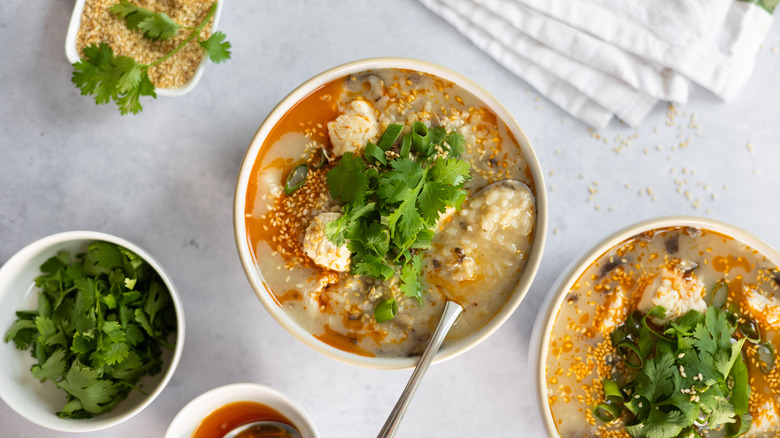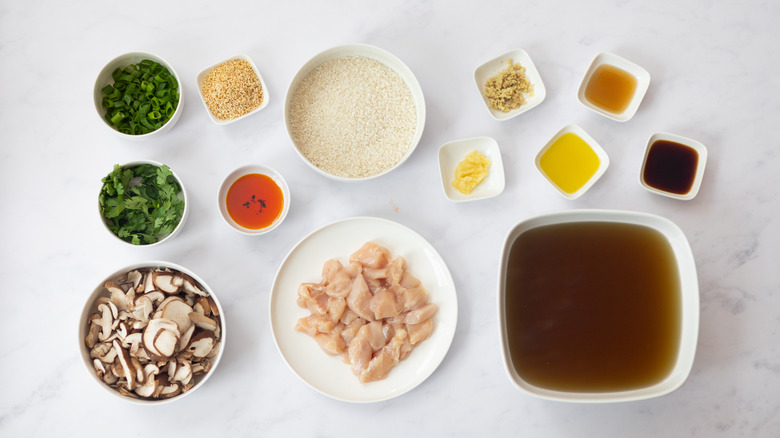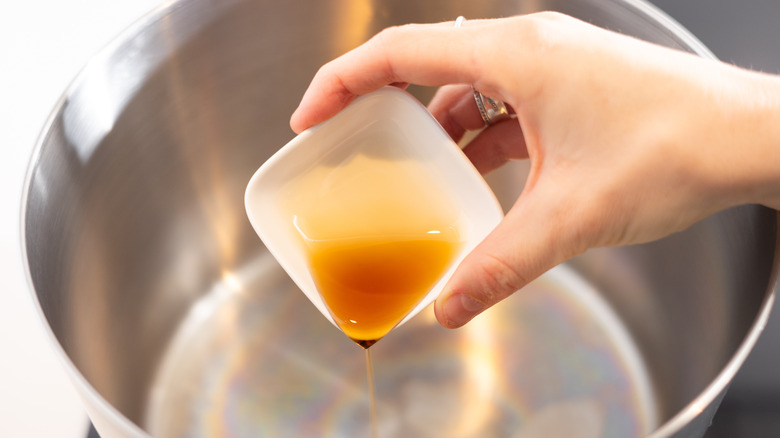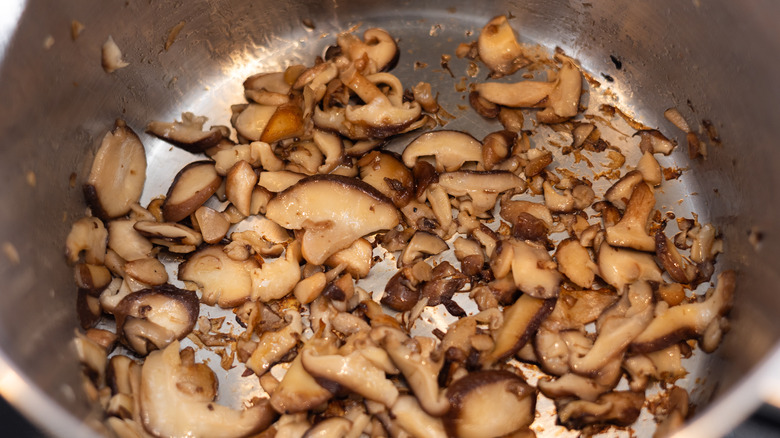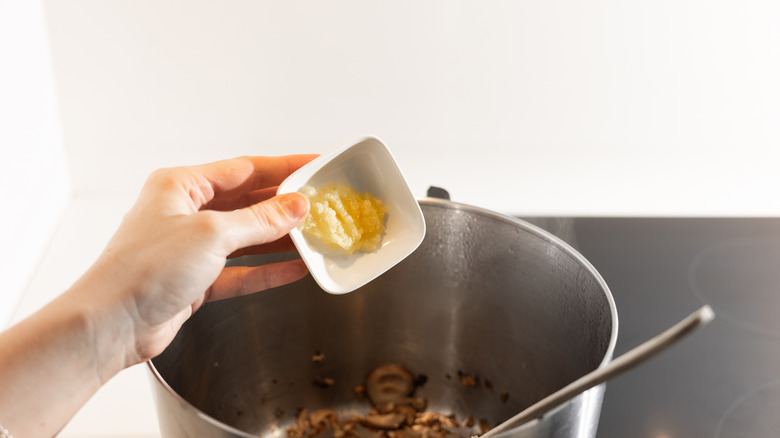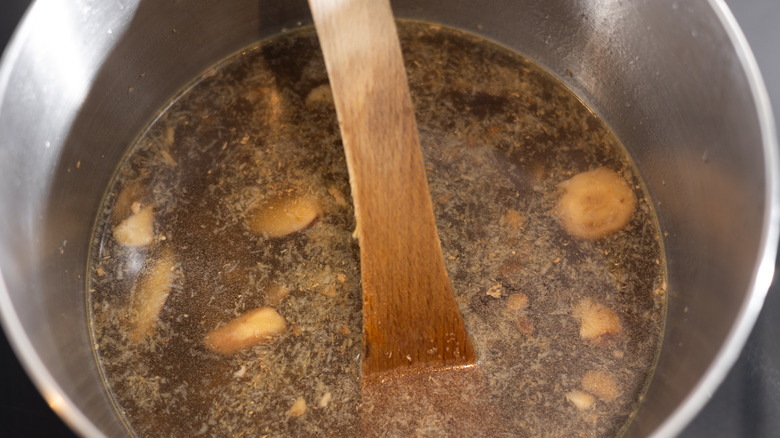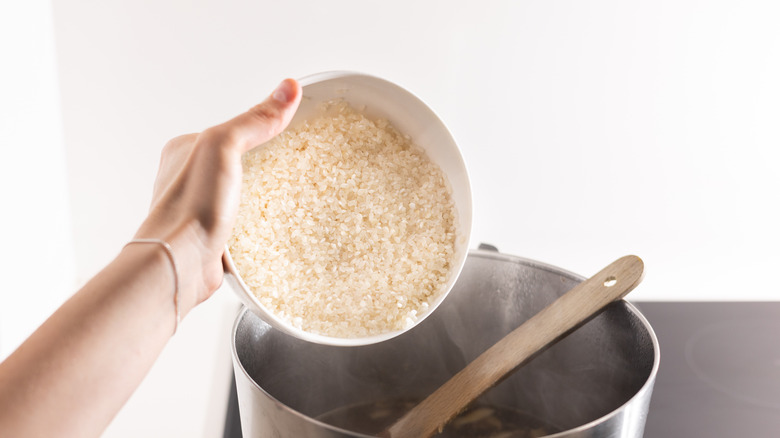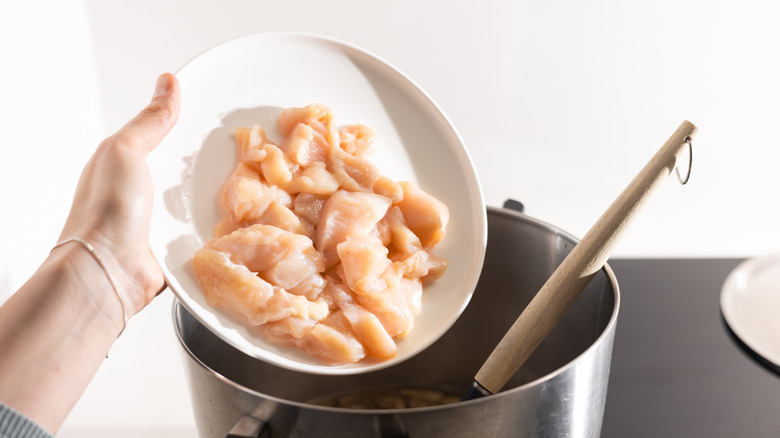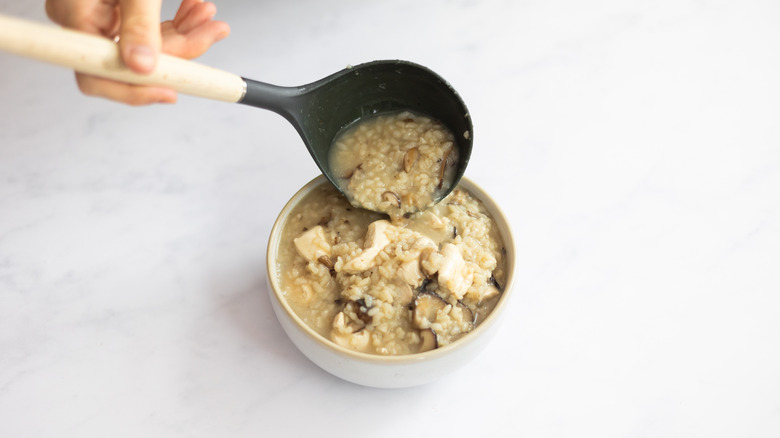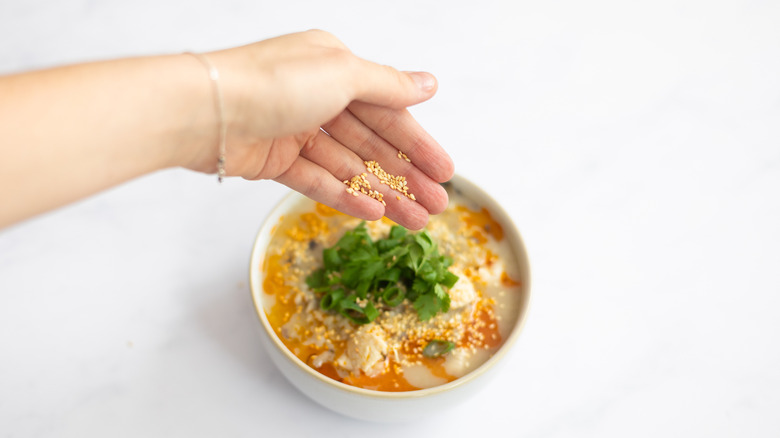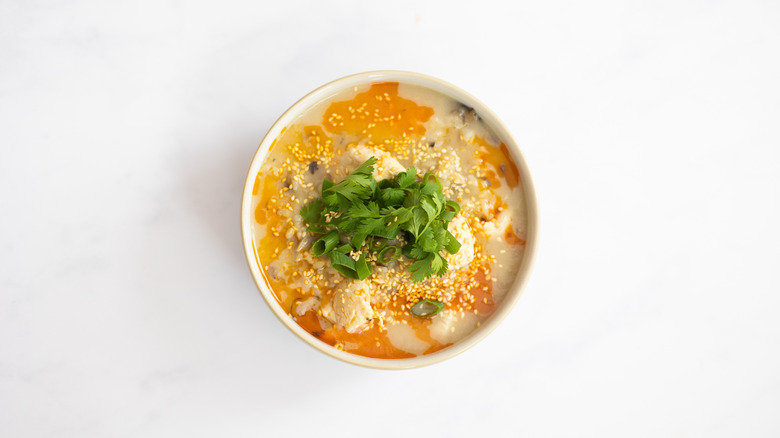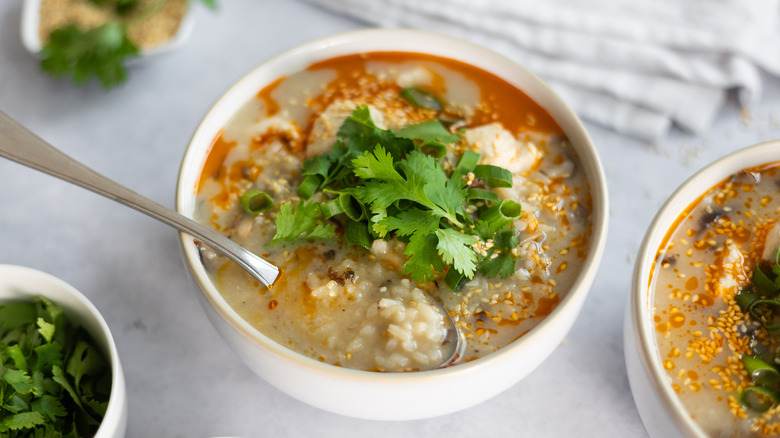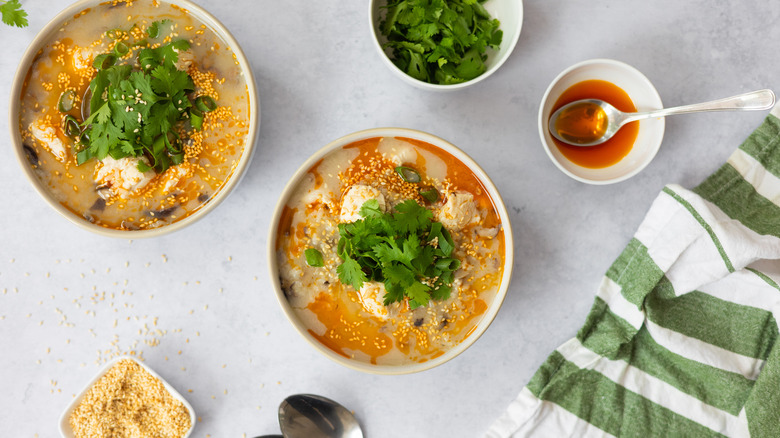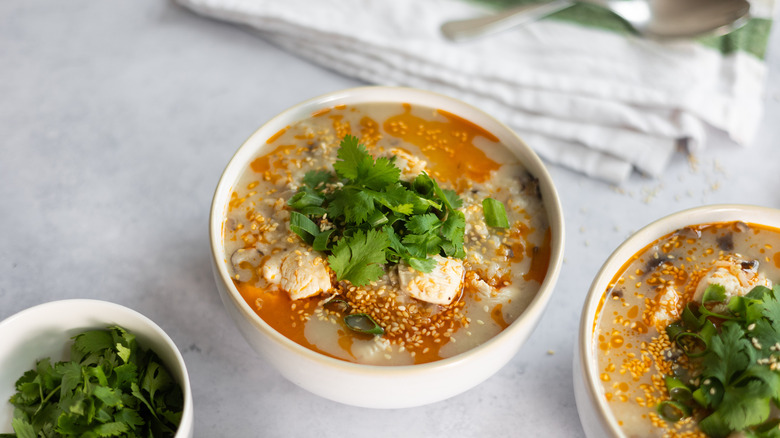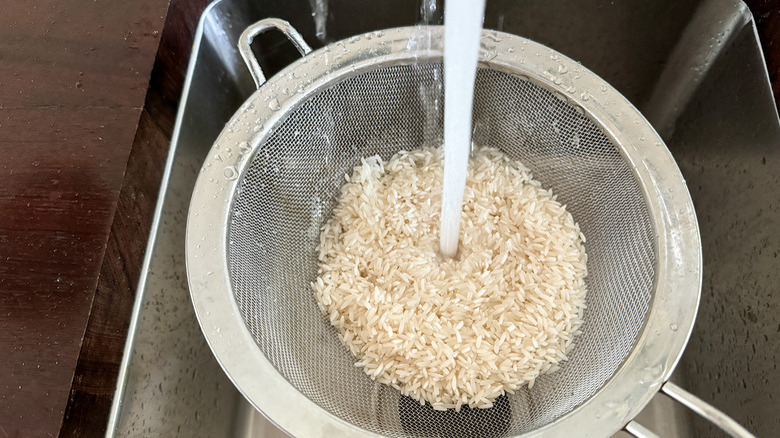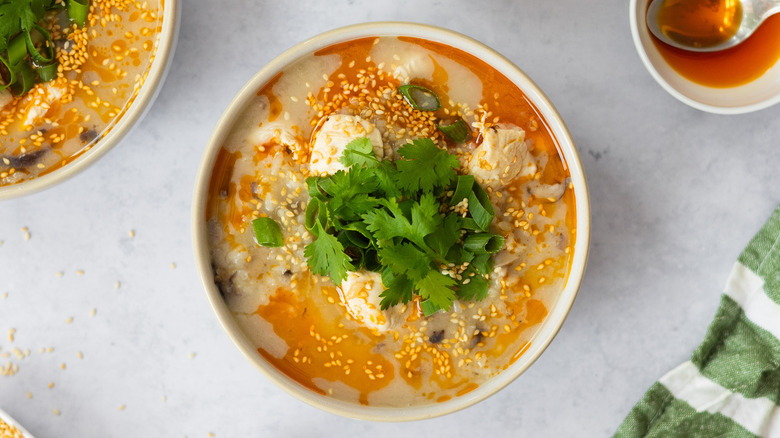Comforting Ginger Chicken Jook (Rice Porridge) Recipe
This chicken ginger jook is a heartwarming, soul-nourishing dish created by recipe developer Tanika Douglas. This simple recipe artfully combines aromatic ginger, tender chicken, and earthy shiitake mushrooms in a memorable medley of flavors. Jook is the Cantonese variant of a dish beloved across Asian cultures, and has been cooked and adored for centuries. Known as the ultimate comfort food, this rice porridge holds a special place in culinary traditions worldwide.
The comforting chicken ginger jook is built through a harmonious blend of elements: fragrant ginger, earthy shiitake mushrooms, and succulent chicken, all simmered in warm chicken stock and umami-rich soy sauce. The addition of chili oil, scallions, coriander, and toasted sesame seeds not only elevates the flavors but also creates a visually appealing and aromatic experience.
With a preparation time of just 5 minutes and a cook time of 40 minutes, this recipe serves up to four people, making it an ideal choice for family dinners or intimate gatherings. Whether it's a chilly evening or a craving for a comforting meal to start the day, this recipe promises warmth, nourishment, and ease.
Gather the ingredients for the comforting ginger chicken jook
To create this comforting ginger chicken jook, you will need: sesame oil, vegetable oil, shiitake mushrooms, garlic, ginger, chicken stock, soy sauce, short-grain rice, chicken breast, chili oil, scallions, coriander leaves, and sesame seeds.
Shiitake mushrooms, renowned for their earthy richness and abundance of nutrients, imbue the jook with a meaty texture and umami depth, elevating its savory profile. The trusted combination of minced garlic and finely grated ginger infuses the rice with a warmth and earthy fragrance. Yet, the heart of this creation lies within the chicken stock, a flavorful elixir that forms the base, marrying with soy sauce to create a broth that anchors the recipe, and gives the rich, layered umami flavor.
The short-grain rice is the backbone of this recipe, releasing its starch to weave the velvety texture that defines congee, thick and creamy as it simmers gently with the other ingredients. The sliced chicken adds a heartiness and absorbs the unique essence of the broth, adding a layer of satisfying protein to this nourishing meal. A dash of chili oil sparks the senses, while scallions, coriander leaves, and toasted sesame seeds offer vibrance and texture. Each ingredient in this jook plays its role in creating an enjoyable, nourishing eating experience.
Step 1: Place the pot over heat
Place a large pot over medium high heat and add the sesame oil and vegetable oil.
Step 2: Cook the mushrooms
Add the shiitake mushrooms, and cook for 5 minutes or until golden brown, stirring intermittently.
Step 3: Cook the garlic and ginger
Add the garlic and ginger and cook for 1 minute, stirring, or until fragrant.
Step 4: Add the chicken stock and soy sauce
Pour in the chicken stock and soy sauce, and bring to a boil, then turn down to a simmer.
Step 5: Cook the rice
Add the rice, cover with the lid, and allow it to cook for 30 minutes or until creamy, and the rice is tender. Stir occasionally.
Step 6: Poach the chicken
Add the chicken and allow it to poach for 2 minutes or until cooked through.
Step 7: Spoon into bowls
Turn off the heat, and spoon the chicken congee into the serving bowls.
Step 8: Garnish
Garnish the congee with chlli oil, scallions, coriander and toasted sesame seeds.
Step 9: Serve the jook
Serve the chicken congee and enjoy.
Where does jook come from?
Jook, a revered dish known by various names like congee or rice porridge, originated thousands of years ago in China, where it was a staple consumed for its nourishing qualities and was appreciated in traditional Chinese medicine. This humble yet versatile dish has evolved, adapting to diverse cultures throughout Asia, including Japan, Korea, and Thailand, each infusing its unique flavors and ingredients. Beyond being a mere meal, jook holds a deep cultural significance — it's a symbol of comfort, healing, and communal bonding. Traditionally served during times of illness or as a warm, filling breakfast, it embodies the essence of care and sustenance, often prepared with love by family members to nurture and restore health.
With a simple base of rice and water, jook serves as a blank canvas, allowing the incorporation of diverse ingredients to create a dish tailored to individual health needs. This dish's significance extends beyond the kitchen; it's a manifestation of the holistic approach of traditional Chinese medicine and is viewed as a healing remedy for many. In the realm of Chinese medicine, food is not merely sustenance but a potent tool for wellness. Across Asian culture, jook transcends culinary boundaries, woven into cultural rituals and celebrations. The act of preparing and sharing jook signifies unity and togetherness, fostering a sense of belonging and connection within communities. Moreover, its adaptability allows for various interpretations — whether savory or sweet, vegetarian or meat-based — reflecting the diverse tastes and preferences of different regions.
Can I use a different variety of rice for jook or congee?
While varieties of rice can often be used interchangeably in many recipes, short-grain rice is the most superior choice in this delicious, comforting dish. Short-grain rice stands as the quintessential choice for crafting the velvety texture and creamy consistency that defines jook. Its distinct starchiness, when gently simmered in the broth, releases a warming creaminess, transforming the dish into a comforting, silky porridge. The compact, plump grains of short-grain rice readily absorb liquid, gradually breaking down to create a hearty base — a hallmark of traditional Jook.
If you are having trouble sourcing standard short-grain rice, Arborio rice, renowned for its use in Italian risotto, presents a plausible alternative due to its similar high starch content and ability to produce a creamy texture when cooked slowly. While it differs in origin and usual culinary applications, Arborio's starch composition makes it the closest counterpart to short-grain rice for Jook, albeit with a slightly different taste profile. The substitution of Arborio rice, though not traditional, offers a viable option for those seeking to achieve a creamy consistency similar to that of short-grain rice, when crafting this beloved dish.
Is there a difference between congee and jook?
Though congee and jook are both rice porridges, there are some differences between the two, which come down to name, origin, and subtle variations in preparation and garnishes. Congee is a more generic name for the many types of rice porridge found throughout Asia, whereas jook is specifically associated with one place: the southern Chinese region of Guangdong.
The term "congee" comes from the Tamil language by way of Portuguese explorers and British colonists. "Kanji" in Tamil means "boilings" and refers to both the porridge itself and the water in which the rice is boiled. It became "canje" in Portuguese before the British settled on "congee." The name "jook," which is also sometimes spelled "juk" or "chuk," had a more direct route to its current usage: It's an English translation of a Cantonese word that simply means "rice porridge."
Because jook is specific to Southern China, the seasonings and toppings used to make it are typical of the cuisine of that region. This distinction is the main feature that sets jook apart from the many varieties of congee found elsewhere. You might find jook served with bok choy, scallions, ginger, sesame oil, boiled eggs, and soy sauce, with each person who is sharing the meal adding seasonings to their taste.
Should you rinse the rice before making jook?
Most jook recipes require you to wash the rice before you prepare the congee. This might involve mixing the rice with water in a bowl and using your hands to gently stir it or running it through your fingers to remove excess starch and dirt. You can also add the rice to a strainer and run cold water through it until the water becomes less cloudy. It can take a few rinses before the rice is prepared to cook, however, you don't want to rinse it too many times because some of the starch is necessary to thicken the jook.
Although both congee and jook are meant to be thick and comforting porridges, a too sticky or stodgy consistency is not desirable. By removing some of the excess starch, which is the culprit when it comes to gummy rice, you ensure that you will have a lighter and fluffier porridge that's silky and creamy rather than slimy or gelatinous. Some brands offer pre-washed or pre-rinsed rice, and if you manage to track that down, you can skip the rinsing step.
How should I store leftover chicken jook?
Like most foods, jook is best when freshly prepared. If you happen to have some leftovers, though, jook can be stored in an airtight container and refrigerated for up to 5 days. It can also be frozen for a month in an airtight container or freezer bag. You can also freeze it in single serving sizes in smaller freezer bags stored flat for quicker thawing and reheating. If you choose to freeze leftover jook, you'll want to thaw it in the fridge before you reheat it. You can reheat jook on the stove or in a microwave, and if it has thickened considerably, simply add water or stock until you reach your desired consistency.
If you find that the jook has lost some of its flavor during the freezing and reheating process, you can liven it up with a variety of seasonings and toppings. Try crushed peanuts, dried pork shavings, or some extra ginger or soy sauce.
Comforting Ginger Chicken Jook Recipe
Rice porridge is a comforting dish found in many different Asian cultures. This recipe for jook, the Cantonese version, comes together in under an hour.
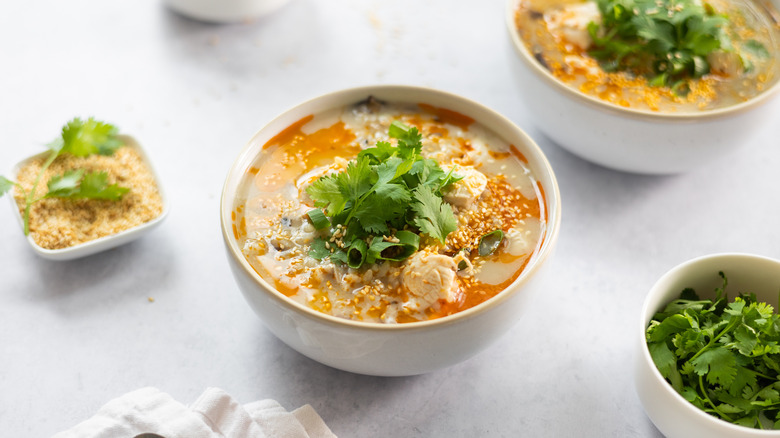
Ingredients
- 1 ½ teaspoons sesame oil
- 1 tablespoon vegetable oil
- ½ pound shiitake mushrooms, sliced thinly
- 2 cloves minced garlic
- 2 teaspoons finely grated ginger
- 6 cups chicken stock
- 1 tablespoon soy sauce
- 1 cup short-grain rice, lightly rinsed
- 9 pounds chicken breast, sliced into pieces
- 2 tablespoons chili oil
- ½ cup sliced scallions
- ½ cup coriander leaves
- 1 tablespoon sesame seeds, toasted
Directions
- Place a large pot over medium high heat and add the sesame oil and vegetable oil.
- Add the shiitake mushrooms, and cook for 5 minutes or until golden brown, stirring intermittently.
- Add the garlic and ginger and cook for 1 minute, stirring, or until fragrant.
- Pour in the chicken stock and soy sauce, and bring to a boil, then turn down to a simmer.
- Add the rice, cover with the lid, and allow it to cook for 30 minutes or until creamy, and the rice is tender. Stir occasionally.
- Add the chicken and allow it to poach for 2 minutes or until cooked through.
- Turn off the heat, and spoon the chicken congee into the serving bowls.
- Garnish the congee with chlli oil, scallions, coriander and toasted sesame seeds.
- Serve the chicken congee and enjoy.
